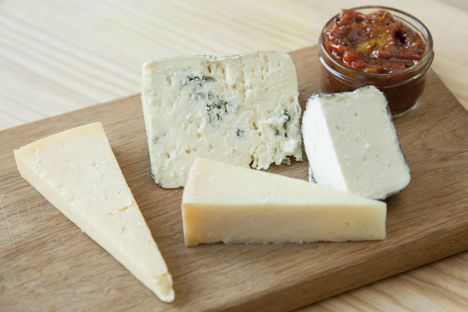
Vive la différence!
We explore the glorious state of cheese production in France and the UK – the long history as well as modern innovators – and find out why British cheesemakers are finally giving the French a run for their money.
Vive la différence!
We explore the glorious state of cheese production in France and the UK – the long history as well as modern innovators – and find out why British cheesemakers are finally giving the French a run for their money.
Thought to be introduced to France by the Romans – themselves master cheesemakers – cheese has been made in the region for thousands of years. The art of crafting cheese was taken on in earnest by the Catholic monasteries, beginning an evolving art that has developed across the country over many centuries. The reverence for and protection of these artisan cheeses has a history in France that stretches back to 1411, when the production of Roquefort was first regulated by Parliament. There have traditionally been between 350 and 400 types of cheese made in France, but modern varieties probably bring today's number closer to 1000. However, French cheesemakers are ageing and retiring, and the next generation is reluctant to take up this labour-intensive work. Although there are many hundreds more cheesemakers in France than in the UK, the production of single-farm cheeses, made by the farmer with their own high-quality milk, is now less common in France.
Cheesemaking in Britain has also been practised for the past 2000 years, with cheddar being made in Somerset since the twelfth century. When the First World War started in 1914, Britain had 3500 independent cheesemakers. Even up to the Second World War, there were 514 farms producing cheddar alone. But the Second World War saw new laws come into effect – all milk had to be sold to The Milk Board for rationing and the only cheese it was legal to produce was a young, generic cheddar, known as Government Cheddar. This situation prevailed until rationing ended in 1954, by which time the number of cheesemakers in the country had plummeted to less than 100. Many, many traditional recipes for cheese, as well as the insight and accumulated knowledge of a life dedicated to curdling milk, was lost forever.
But the 1980s saw the beginning of a renaissance, sparked by pioneers like James Aldridge and Patrick Rance. This revival of specialist farmhouse cheeses saw cheesemaking in Britain blossom; even the 2001 foot and mouth outbreak, which resulted in the culling of more than ten million cows and sheep, did not halt these developments. There are now several hundred specialist cheesemakers in the UK, producing anywhere up to 1000 varieties of cheese (depending on whose estimate you go with); an array remarkably similar to that found in France.
Where the state of cheese production in France is one born of respected tradition – with fifty-one European protected cheeses to show for it – in Britain modern cheese is born of innovation, ingenuity and personal passion. In tandem with the developments in farmhouse cheeses, the quality of cheddar, Red Leicester and Gloucester has improved enormously in the past two decades. Cheddar remains Britain's most popular cheese – one of the most consumed types in the world – with customers now demanding tastier, longer-aged cheeses; two thirds of the cheddar sold in the UK is now mature.
Emmental and camembert are the most popular cheeses in France, and anyone who has visited a supermarché of late will have seen the wide array of Emmentals, looking to the British eye much like our supermarket cheddar displays. Where Britain produces around 280,000 tonnes of cheddar a year (provisional 2014 figures), the picture in France is similar with 250,000 tonnes of Emmental typically made, using 13% of France's entire milk supply (2005 figures). Where the standard Briton eats 3.48kg of cheddar a year, the French cheese-lover consumes 3.3kg of Emmental.
And now France has finally got a taste for British cheese. Where UK sales of French cheese are falling, the reverse is true in France. Sales of British cheeses were up 20% and the rise of le fromage Anglais is noted regularly in the French media.
The fact is that cheese in both France and the UK is thriving – a true lover of cheese would be churlish to try and pick between the two. The question of who makes the most types of cheese and how many of those types are truly unique is repeatedly debated, but it is beside the point. The thing to hold sight of is that both countries are probably producing close to 1000 different cheeses, for every possible kind of consumer. In Britain that means those handcrafted, artisan cheeses, but also cheddars like Davidstow – one of the most popular cheeses in Britain, which in the past few years has added a three-year mature cheddar to its range, and still follows traditional methods, such as using specially blended starter cultures and grading the cheeses before maturation to ensure high quality stocks.
Meanwhile, France continues to produce many, many fabulous cheeses, but perhaps for the first time, with one eye on what the dedicated cheese innovators of the United Kingdom are up to this year.


